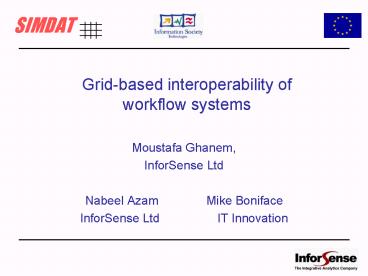Gridbased interoperability of workflow systems - PowerPoint PPT Presentation
Title:
Gridbased interoperability of workflow systems
Description:
Example Aero design workflows. Aerodynamics (BAE) Design (UoS) Compute (UoS) S7. S8 ... Example: Aero application. Method 2: Workflow enactment engine as service ... – PowerPoint PPT presentation
Number of Views:65
Avg rating:3.0/5.0
Title: Gridbased interoperability of workflow systems
1
Grid-based interoperability of workflow systems
- Moustafa Ghanem,
- InforSense Ltd
- Nabeel Azam Mike Boniface
- InforSense Ltd IT Innovation
2
Background SIMDAT
www.simdat.org
- Developing and applying Grid technology to
support - Distributed, Cross-organizational, product and
process development
3
Example Auto design workflows
4
Example Aero design workflows
5
SOA and Workflows A programmers view
Services
Services
Services
6
Key challenge for workflow in SIMDAT
- There are 26 partners in SIMDAT
- At least 3 workflow systems in use
- InforSense KDE
- Taverna/Freefluo
- LMS Optimus
- Other approaches include
- Various hard-coded wf applications
- BPEL
- Agreeing/Using a common workflow system (or
language) is difficult - Migration may require huge re-investments
- Continued debate on open source vs. proprietary
- In general, virtual organizations are dynamic
- What happens when we add new partners?
SIMDAT partners
7
Workflow Systems Are they really similar?
8
Workflow systems quick comparison
- Similarities
- All have drag-drop GUIs
- All use XML-based languages
- Similar conceptual model
- Differences
- Different language paradigms/semantics
- Pure Data Flow vs. Control Flow
- Iterations (not available, implicit, explicit ?)
- Data types and operators supported
- Varying degrees of abstraction
- Node granularity
- Service call vs. abstract task
- Different systems specialized to particular
applications - Specialized viewers
- Specialized helper nodes for data manipulation
9
Grid-based interoperability of workflow systems
10
Calling Grid Services vs Web Services
11
Example Using of GRIA services
- GRIA uses a fully decentralized management
approach, with minimal dependency between sites.
- Each site offering GRIA services makes its own
business decisions about which users to trust and
on what terms, and is responsible for enforcing
its own access policies and deciding which
applications to support. - Sites can interact with each other, but this is
driven by their common consumers, and those
consumers are responsible for managing the
resulting dependencies. - There are no global agreements to set up, and no
virtual organizations need be established, though
users can interact according to virtual
organization models if they want.
12
Example Pharma application
- Five basic Sub-workflow nodes
- Allocate Resources
- Upload Inputs
- Execute
- Retrieve Result
- Finish Conversation
13
Grid-based workflows and interoperability
- Run-time interoperability
- Workflow-based applications as services
- Workflow enactment as services
14
Method 1 Workflow-based application as service
15
Example Aero application
16
Method 2 Workflow enactment engine as service
17
Interoperability interaction patterns
18
Current Status
19
Next Steps Moving from abstract to heterogeneous
executable workflows
20
Overall approach
- User specifies high-level steps
- Steps iteratively instantiated using services and
workflow templates - Use service registries and workflow warehouses
- Use existing run-time interoperability mechanisms
21
Architecture
- Heterogeneous workflow warehouse
- InforSense Workflow warehouse
- Service Registries
- NEC Semantic Broker
- Authoring advisor high-level steps for
application domains - Authoring assistant map from abstract tasks to
workflow fragments and services
22
Workflow warehousing and mining
23
Summary
- Using industrial strength workflow systems for
cross-organization product design - Run-time interoperability mechanisms
- Supporting the design of heterogeneous workflows































